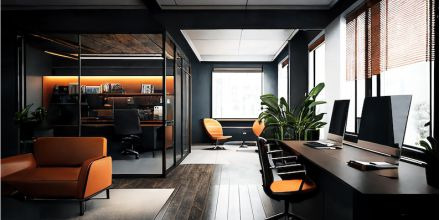
Corporate Interiors
Corporate interiors are designed to create functional and aesthetically pleasing spaces within corporate or business environments. The goal is to enhance productivity, promote employee well-being, and project a positive image for clients and visitors.
Space Planning: Efficient space planning is crucial in corporate interiors. Designers analyze the available space and strategically allocate areas for workstations, meeting rooms, collaborative spaces, and other functional areas. Effective space planning optimizes workflow and encourages collaboration among employees.
Branding and Identity: : Corporate interiors serve as an opportunity to express a company's brand identity and values. Design elements such as colors, textures, materials, and signage are carefully chosen to align with the company's brand image. This creates a consistent and cohesive visual experience that reinforces the company's identity.
Functionality and Ergonomics: Functionality and ergonomics are key considerations in corporate interior design. The layout and selection of furniture, lighting, and equipment are focused on creating a comfortable and efficient working environment. Ergonomic principles are applied to ensure that workstations and seating support proper posture and reduce the risk of injuries or discomfort.
Multifunctional spaces: Today, drawing rooms are often designed to serve multiple purposes. They can be used for relaxation, entertainment, socializing, and even as a home office or study area. This versatility allows homeowners to make the most of the space according to their needs.
Technology Integration: : In the modern corporate world, technology plays a vital role. Corporate interiors often incorporate advanced technologies such as video conferencing systems, smart boards, and integrated communication tools.
Sustainability: : Many companies prioritize sustainable practices, and this extends to corporate interiors. Sustainable design principles, such as using eco-friendly materials, energy-efficient lighting, and incorporating recycling and waste management systems, are integrated into the design.
Acoustics and Privacy: Noise control and privacy are important considerations in corporate interiors. Acoustic design elements are incorporated to minimize noise disruptions and create a comfortable working environment. This may include the use of sound-absorbing materials, strategic layout planning, and the inclusion of private meeting rooms or soundproof booths.
Flexibility and Adaptability: Corporate interiors should be designed with flexibility and adaptability in mind. Spaces need to accommodate changing needs, such as reconfigurations, expansion, or the integration of new technologies. Flexible furniture, movable walls, and modular design solutions allow for easy reconfiguration and adaptability to future changes.
By considering these various factors, corporate interior design creates functional, visually appealing, and employee-centric spaces that align with the company's brand and goals.
